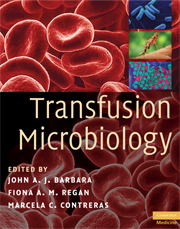Book contents
- Frontmatter
- Contents
- List of contributors
- Foreword
- Preface
- Acknowledgements
- Glossary
- Introduction: Transfusion-transmitted infections, then and now
- Section 1 Agents
- 1 Hepatitis viruses
- 2 Antibody to hepatitis B core antigen
- 3 Herpes viruses
- 4 Retroviruses
- 5 Parvovirus B19 (human erythroviruses)
- 6 Emerging viruses in transfusion
- 7 Bacterial contamination in blood and blood components
- 8 The protozoan parasites
- 9 Prion diseases
- Section 2 Selection and testing
- Section 3 Surveillance, risk and regulation
- Index
- Plate section
- References
9 - Prion diseases
from Section 1 - Agents
Published online by Cambridge University Press: 12 January 2010
- Frontmatter
- Contents
- List of contributors
- Foreword
- Preface
- Acknowledgements
- Glossary
- Introduction: Transfusion-transmitted infections, then and now
- Section 1 Agents
- 1 Hepatitis viruses
- 2 Antibody to hepatitis B core antigen
- 3 Herpes viruses
- 4 Retroviruses
- 5 Parvovirus B19 (human erythroviruses)
- 6 Emerging viruses in transfusion
- 7 Bacterial contamination in blood and blood components
- 8 The protozoan parasites
- 9 Prion diseases
- Section 2 Selection and testing
- Section 3 Surveillance, risk and regulation
- Index
- Plate section
- References
Summary
Introduction
Prion diseases include a spectrum of disorders in animals and man (see Table 9.1). Scrapie, endemic in sheep and goat populations throughout most of the world, was first recognized over 250 years ago and was demonstrated to be experimentally transmissible in 1936. Chronic wasting disease (CWD) is endemic in Rocky Mountain elk, white-tailed deer and mule deer in several areas of the USA and is increasing in both incidence and geographic distribution. The routes by which these two endemic prion diseases are transmitted remain unclear. Transmissible mink encephalopathy was first recorded to have occurred in 1947 in farmed mink in Wisconsin and was probably transmitted through prion infected food.
Bovine spongiform encephalopathy (BSE) was first recognized in the UK in 1985/86 (Wells et al., 1987). Affected cattle become apprehensive, hypersensitive, ataxic and generally difficult to handle, giving rise to the common name of mad cow disease. It remains unclear whether BSE arose spontaneously in cattle or resulted from transmission of scrapie from sheep, but onward transmission is thought to have occurred through the practice of feeding cattle ruminant-derived meat and bone meal. Over 180,000 clinical cases of BSE have been reported in the UK since 1985, though the annual incidence has now fallen to just over 100 cases per annum. Over 4500 infected cattle have been detected elsewhere, mainly in Europe, the majority associated with the export of BSE infected cattle or meat and bone meal from the UK. It is estimated that between 1 and 2 million cattle may have become infected and entered the human food chain before developing evidence of clinical disease (Donnelly et al. 2002).
- Type
- Chapter
- Information
- Transfusion Microbiology , pp. 141 - 152Publisher: Cambridge University PressPrint publication year: 2008



